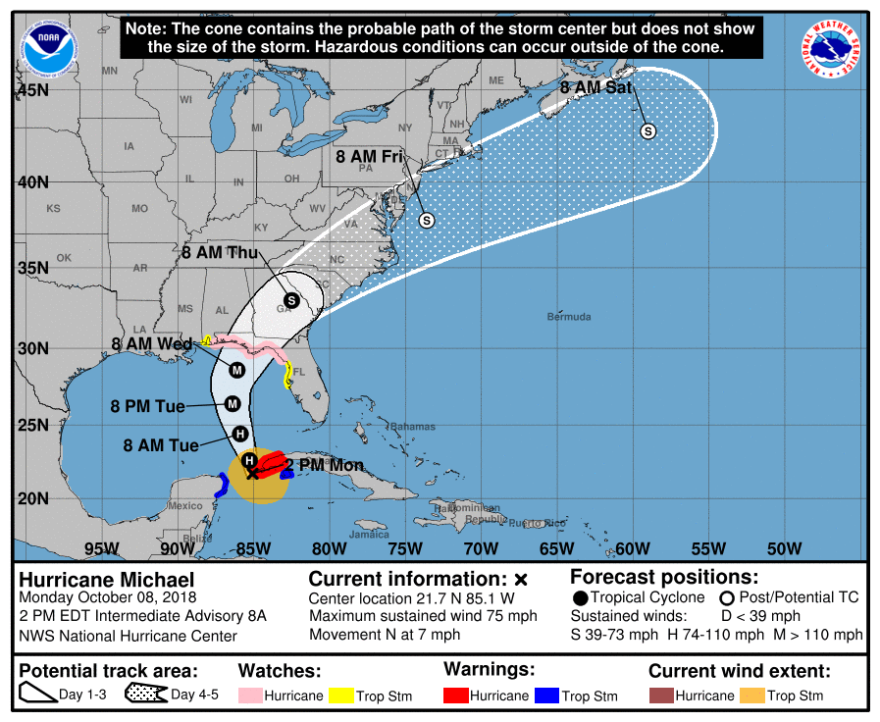As Hurricane Michael churns through the Gulf of Mexico, Gov. Rick Scott visited the Escambia County Emergency Operations Center on Monday, for a briefing on the storm. WUWF’s Dave Dunwoody reports Pensacola is under a hurricane warning by the National Hurricane Center.
The Governor was in Pensacola late Monday afternoon, after briefings in Southport and New Port Richey on the 13th named storm of the 2018 season. His repeated message: do whatever it takes to stay safe.
“I know evacuations are not fun and they’re inconvenient; but in Florida, there are so many people ready to help you, and there’s no excuse not to keep your family safe,” said Scott. “Keep your kids safe; keep your pets safe, do not wait. [Michael] could speed up and start impacting us significantly [Tuesday] night. Making decisions [Tuesday] could be too late.”
Michael and its 80 mph sustained winds were located about 520 miles south of Apalachicola, moving north at nine miles an hour. Hurricane-force winds extend up to 30 miles from the storm's center – and tropical-storm-force winds extending up to 175 miles. Storm surge could be 12 feet in some places.
“Don’t take a chance’ there’s no reason to ride this thing out; storm surge is deadly. You’re not going to survive storm surge like this,” said the Governor. “You can visit www.floridadisaster.org to make a plan and get information on road closures, shelters, and evacuation routes.”
After becoming a hurricane on Monday, Michael is expected to keep growing perhaps into a Category-2 or three storm after spending 2-3 days over the Gulf of Mexico, its very warm waters and favorable atmospheric conditions. Landfall is projected for Wednesday, either in the Panhandle or Big Bend. Scott urged local governments to work with utilities in power restoration.

“I’ve been talking to the utilities; we’re trying to make sure everybody has all the resources they need,” Scott told local leaders. “[If] we’re going to lose power make sure everybody’s thinking about how we’re going to get the power back on as quickly as we can.”
“Getting the lights back on, getting the power back on is the top priority.”
The Governor on Sunday declared a state of emergency for 35 counties -- from Pensacola to Tampa -- to rush preparations, free up resources and activate 500 Florida National Guard members.
“This is not rocket science, folks; we’ve done this time and time and time again. Follow directions, you know when to evacuate and that’s when you’re told to evacuate,” said Escambia County Sheriff David Morgan.
“There will come a point in time in the disaster – if it in fact makes landfall somewhere near Escambia County – and of course the City of Pensacola – where we shelter in place. Meaning all first responders are not allowed to respond; that’s the most dangerous time.”
“So if you decide to stay in your home and a tree falls on your house, or storm surge catches you, there’s no one that can respond to help you.”
Michael's large size, strong winds and heavy rains could produce hazardous flooding along a stretch of Florida's Gulf coast. John Purdy at the National Weather Service in Mobile says the size of the storm also could create a rather large wind field.
“With winds out of the northeast on the back side, the west side of Michael; that could result in downed trees and possible power lines,” Purdy says. “So we’re keeping an eye out for the impacts from winds.”
Some Panhandle communities could get a foot of rain, as Michael moves inland. Purdy says Michael’s eastward shift in the past few days has been influenced by a large trough across the western United States.
“And as that trough continues to dig, it kinda nudges it a little bit further to the east,” says Purdy. “I guess the good news is for our area is we’ll be on the west side of major Hurricane Michael, which has the lower impacts and drier weather.”
Local emergency ops centers are monitoring the situation, including Escambia County – where Chris Holloman is Operations Coordinator.
“Receiving updates from the National Weather Service,” Holloman says. “They are showing [Michael] to go well east of us – Panama City, Apalachicola area – which is favorable for us. However, that could change really at any moment.”
Residents can help out by keeping tabs on Michael through the media, and by getting ready in case it’s time to get moving. And Holloman says don’t take the “Cone of Uncertainty” surrounding the storm on the National Hurricane Center’s website as the gospel.
“Receiving updates from the National Weather Service,” Holloman says. “They are showing [Michael] to go well east of us – Panama City, Apalachicola area – which is favorable for us. However, that could change really at any moment.”
More information is available at your county’s official website.

